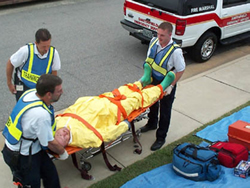Improved Criteria for Emergency Medical Protective Clothing
Posted on by It is estimated there are over 1 million firefighters and an additional 500,000 Emergency Medical Technicians and other first responders engaged in emergency medical service (EMS) operations. These EMS responders routinely are exposed to a wide range of hazards, including blood borne pathogens that require the use of personal protective equipment (PPE). Requirements for emergency medical personal protective clothing and equipment have been established in the National Fire Protection Association’s (NFPA) Standard number 1999, Protective Clothing for Emergency Medicals Operations. The 2003 edition of NFPA 1999 contained a number of deficiencies identified by the responsible committee, NFPA Technical Committee on Emergency Medical Operations Protective Clothing and Equipment. These deficiencies were primarily clothing/equipment categories where industry had not responded with certified products even though these items are understood to be extensively used during emergency medical operations. To address this issue, researchers at the National Institute for Occupational Safety and Health (NIOSH) along with external partners, assessed the hazards faced by EMS workers, met with EMS responders to learn about their PPE needs, and evaluated available PPE to determine the appropriate technical performance levels necessary for a suite of PPE including: garments, gloves, footwear covers, respiratory protection, eye/face wear and head protection.
It is estimated there are over 1 million firefighters and an additional 500,000 Emergency Medical Technicians and other first responders engaged in emergency medical service (EMS) operations. These EMS responders routinely are exposed to a wide range of hazards, including blood borne pathogens that require the use of personal protective equipment (PPE). Requirements for emergency medical personal protective clothing and equipment have been established in the National Fire Protection Association’s (NFPA) Standard number 1999, Protective Clothing for Emergency Medicals Operations. The 2003 edition of NFPA 1999 contained a number of deficiencies identified by the responsible committee, NFPA Technical Committee on Emergency Medical Operations Protective Clothing and Equipment. These deficiencies were primarily clothing/equipment categories where industry had not responded with certified products even though these items are understood to be extensively used during emergency medical operations. To address this issue, researchers at the National Institute for Occupational Safety and Health (NIOSH) along with external partners, assessed the hazards faced by EMS workers, met with EMS responders to learn about their PPE needs, and evaluated available PPE to determine the appropriate technical performance levels necessary for a suite of PPE including: garments, gloves, footwear covers, respiratory protection, eye/face wear and head protection.

NIOSH and its partners evaluated the PPE commercially available at the time of the research through extensive laboratory testing and user wear assessment to determine appropriate technical performance levels necessary to protect EMS responders. The majority of the research effort was undertaken during 2006 and 2007. The National Fire Protection Association (NFPA) incorporated NIOSH research results into the NFPA 1999 Standard on Protective Clothing for Emergency Medical Operations, 2008 edition. NFPA standards are recognized by numerous industries as the basis for equipment quality and performance. This is especially applicable for the first responder industry. Many NFPA standards including the NFPA 1999 Standard on Protective Clothing for Emergency Medical Operations, 2008 edition have been adopted by the Department of Homeland Security, making compliance with the standard a requirement for use of federal grant money.
PPE certified to the 2008 edition of the NFPA standard is now available, enabling a level of protection not previously provided to the nation’s EMS responders. NFPA 1999 contains requirements for certification of a range of products including single use and multiple use garments; examination, cleaning and work gloves; eye and face protection; and single use and multiple use footwear. The certification of individual products allows users to select the appropriate level of protection necessary for each response. As of November 20, 2008 there were 26 manufacturers with a total number of 82 products certified to the 2008 edition of NFPA 1999.
Two notable areas where the number of certified products has increased under the new edition are reusable footwear and work gloves. These two areas had seen relatively little or no certification efforts prior to the 2008 edition. The expectation is for this trend of additional certified products to continue with single use garments and single use footwear.
The EMS PPE study has lead to other similarly designed research projects that will address other types of protective clothing and was showcased as an example of a Research to Practice effort within NIOSH. The process instituted for the EMS study focused on optimizing existing test methods, through research, to set new, balanced, performance and design requirements. This research approach will be applied to PPE for other industries and will result in standards that define the minimum performance requirements of PPE for workers.
A final report summarizing the EMS research has been prepared and has been made available upon request and through distribution at conferences. To request a copy of the final report, contact Angie Shepherd. In addition to the detailed final report, presentations have been given at three technical conferences including the International Association of Fire Fighters (IAFF) 2007 John P. Redmond Symposium, the Technical Support Working Group (TSWG) Personal Protective Equipment 2007 Conference, and the 2008 American Industrial Hygiene Conference and Expo (AIHce). Two manuscripts are being prepared for publication, and an additional presentation is scheduled at the 2009 Fire Industry Equipment Research Organization (FIERO) PPE Fire Symposium.
—Ed Fries and Angie Shepherd
Mr. Fries serves as the Assistant Coordinator for the NIOSH PPT Program in the NIOSH National Personal Protective Technology Laboratory (NPPTL) Office of the Director.
Ms. Shepherd is a General Engineer in the Technology Research Branch in the NIOSH National Personal Protective Technology Laboratory and was the project officer for this research.
Posted 1/20/09 at 8:27 am
Posted on by

